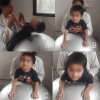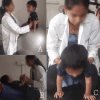Effect of a Tailored Physiotherapy Rehabilitation on Developmental Delay Primary to Non-communicating Hydrocephalus: A Case Study
- PMID: 38962643
- PMCID: PMC11221501
- DOI: 10.7759/cureus.61588
Effect of a Tailored Physiotherapy Rehabilitation on Developmental Delay Primary to Non-communicating Hydrocephalus: A Case Study
Abstract
This case report presents the physiotherapy intervention of a one-year-old male child diagnosed with non-communicating hydrocephalus primary to developmental delay. Hydrocephalus is marked by an accumulation of cerebrospinal fluid and often leads to significant developmental delays and neurological impairments in affected infants. The physiotherapy intervention aimed to achieve head and trunk control, improve sensory awareness, and enhance overall body coordination and balance. Various techniques, including neurodevelopmental techniques, sensory stimulation, hippotherapy, and sensory integration therapy, were utilized to target specific developmental milestones and functional abilities. Outcome measures, including the Gross Motor Function Measure, Infant Neurological International Battery, Hammersmith Infant Neurological Examination, and New Ballard Score, were used to assess the patient's progress pre- and post-intervention. Significant improvements were observed across all outcome measures following four months of physiotherapy rehabilitation. The patient demonstrated substantial gains in gross motor function, neurological examination scores, and overall developmental milestones. These findings underscore the effectiveness of physiotherapy rehabilitation in addressing developmental delays associated with non-communicating hydrocephalus. This case underscores the significance of early physiotherapy intervention, which plays a vital role in enhancing outcomes and improving the quality of life for affected children.
Keywords: developmental delay; hippotherapy; neurodevelopmental techniques; non-communicating hydrocephalus; physiotherapy intervention.
Copyright © 2024, Vikhe et al.
Conflict of interest statement
Human subjects: Consent was obtained or waived by all participants in this study. Conflicts of interest: In compliance with the ICMJE uniform disclosure form, all authors declare the following: Payment/services info: All authors have declared that no financial support was received from any organization for the submitted work. Financial relationships: All authors have declared that they have no financial relationships at present or within the previous three years with any organizations that might have an interest in the submitted work. Other relationships: All authors have declared that there are no other relationships or activities that could appear to have influenced the submitted work.
Figures



Similar articles
-
Physiotherapy Intervention for a 1.5-Year-Old Child With Communicating Hydrocephalus and Developmental Delay Secondary to Torticollis: A Case Report.Cureus. 2024 Sep 26;16(9):e70260. doi: 10.7759/cureus.70260. eCollection 2024 Sep. Cureus. 2024. PMID: 39463541 Free PMC article.
-
The Effect of Physiotherapy Intervention on an Infant With Congenital Heart Defect Associated With Developmental Delay: A Case Report.Cureus. 2024 May 13;16(5):e60215. doi: 10.7759/cureus.60215. eCollection 2024 May. Cureus. 2024. PMID: 38868259 Free PMC article.
-
Effects of a Tailored Pediatric Rehabilitation Protocol on Children With Neurometabolic Disorder: A Case Report.Cureus. 2024 Mar 28;16(3):e57115. doi: 10.7759/cureus.57115. eCollection 2024 Mar. Cureus. 2024. PMID: 38681474 Free PMC article.
-
Early intervention and neurodevelopmental outcome of infants with posthemorrhagic hydrocephalus: A case series and literature review.Clin Neurol Neurosurg. 2021 Feb;201:106432. doi: 10.1016/j.clineuro.2020.106432. Epub 2020 Dec 17. Clin Neurol Neurosurg. 2021. PMID: 33383466 Review.
-
The results of early physiotherapy on a child with incontinentia pigmenti with encephalocele.BMJ Case Rep. 2010 Aug 5;2010:bcr0320102814. doi: 10.1136/bcr.03.2010.2814. BMJ Case Rep. 2010. PMID: 22767665 Free PMC article. Review.
References
-
- Noncommunicating hydrocephalus. Maller VV, Gray RI. Semin Ultrasound CT MR. 2016;37:109–119. - PubMed
-
- Relationship between spinal fluid and cerebrospinal fluid as an index for assessment of non-communicating hydrocephalus. Gholampour S, Seddighi A, Fatouraee N. https://openurl.ebsco.com/contentitem/gcd:99205629?sid=ebsco:plink:crawl... EBSCOhost. 2024;14:308–314.
Publication types
LinkOut - more resources
Full Text Sources
